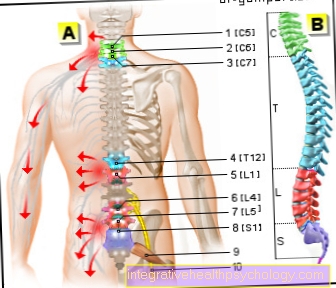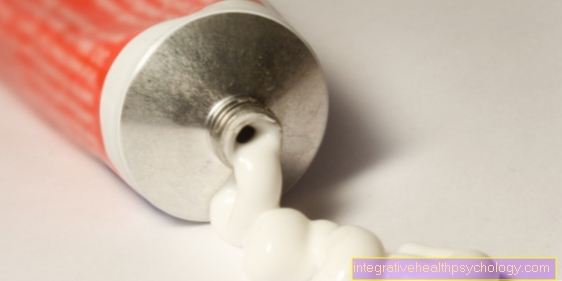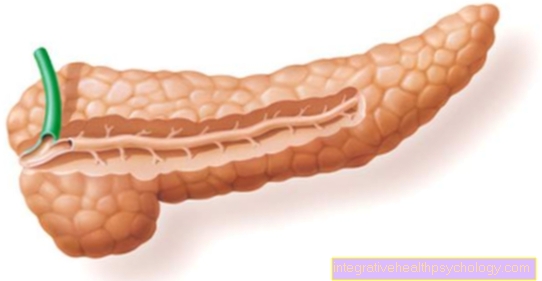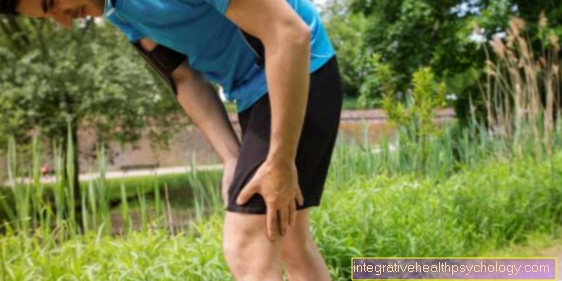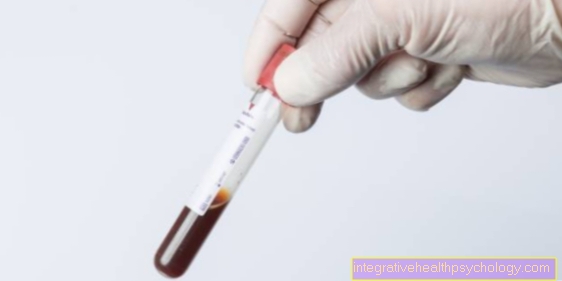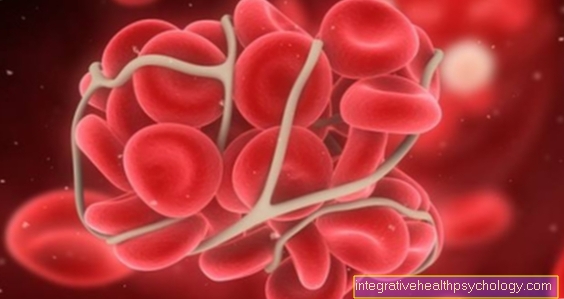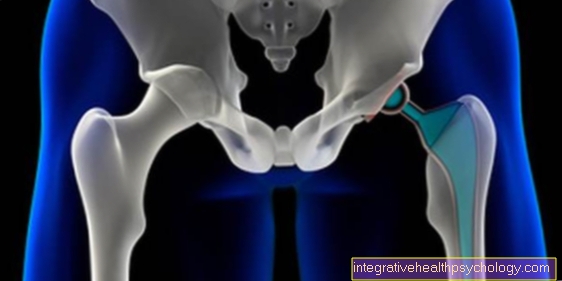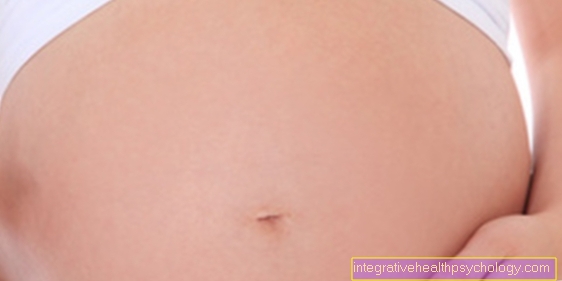Cruciate ligament overstretched
What is an overstretched cruciate ligament?
Humans have two cruciate ligaments in the knee joint, the front and the back, which are responsible, among other things, for stabilization and rotation in the knee. A distinction is therefore made between an anterior and posterior cruciate ligament overstretching. However, usually only one of the two is affected. A stretch of the cruciate ligament is a typical injury in athletes. Overstretching means that the ligament is stretched beyond its original length so that the joint surfaces are levered apart for a short time without tearing the ligament or injuring the skin.
Read more on the topic:
- The anterior cruciate ligament
- The posterior cruciate ligament
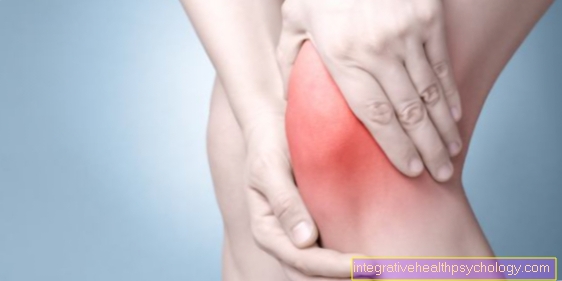
causes
Cruciate ligament overstretching occurs most frequently during exercise. Sports such as soccer, handball, tennis, badminton and skiing, which involve rapid changes of direction and rotational movements with strong shear forces, are typical injuries. If a foot gets stuck in a ski boot or on the lawn, for example, and the knee rotates at the same time, the cruciate ligament is stretched beyond its elastic limit.
In addition, ligament stretching can also result from an external force, for example when the knee is hit or kicked. In rare cases, cruciate ligament overstretching can occur in everyday life as a result of accidents or injuries.
Read more on the topic: The most common sports injuries
You can recognize an overstretched cruciate ligament by these symptoms
An overstretched cruciate ligament is often described as a strain. It usually occurs in connection with a sports accident, an overstretching of the ligaments without external influence is rather unlikely. Typical signs of this are pain and swelling in the knee. However, there are no injuries to the skin or the joint, so that the stability in the knee remains the same. It is therefore still possible to put weight on the knee, although this is associated with movement-dependent pain. This is important when differentiating from a torn ligament, as the normal joint stability is no longer given.
Read more on the topic:
- Anterior cruciate ligament tear
- Posterior cruciate ligament tear
The knee usually swells immediately after the injury, and you also feel a noticeable loss of strength. Compared to a ligament rupture, it is rare that there is a bleeding, i.e. a hematoma formation. Overstretching can also lead to tears in the surrounding structures, for example on the cartilage and meniscus.
Read more on the topic:
- Symptoms of a tear in the meniscus
- Cartilage damage in the knee
Often there is no isolated overstretching of the cruciate ligament, but rather an injury to other ligaments or structures of the knee joint.
Pain
The pain associated with overstretching the cruciate ligament is typically load-dependent, which means that it rarely occurs at rest. However, even a slight step with the leg can lead to pain. In addition, the pain occurs suddenly, i.e. immediately after the injury. They are often perceived as pressing or cutting and are only limited to the knee joint.
If pain occurs at rest and for a longer period of time, a doctor should be consulted, as a cruciate ligament tear or other injury to the knee joint may have to be assumed.
Read more on the topic:
- Knee Pain - What Do I Have?
- Front thigh pain - these are the causes
- Back thigh pain
diagnosis
The diagnosis of an overstretched cruciate ligament is usually made by an orthopedic surgeon or trauma surgeon. The doctor will assess the injury using a medical history and a physical examination. As part of this, the doctor examines the knee and pays attention to knee swelling, pain during stress and movement, and loss of function.
Using various tests, he can assess the different structures of the knee, he will presumably describe the gait pattern and the leg axes, the stability in the knee joint and the surrounding muscles. An important part of the examination after an injury or an accident is always checking the blood flow and sensitivity.
As a rule, the physical examination is sufficient to confirm the suspicion of overstretching, but in rare cases additional apparatus-based procedures may be necessary to rule out any differential diagnoses such as a cruciate ligament or meniscus tear. The doctor can use an ultrasound, an MRI or a CT scan.
Read more on the topic: MRI for a cruciate ligament tear
How does a torn cruciate ligament differ from an overstretched cruciate ligament?
If the cruciate ligament is overstretched, the ligament is stretched far beyond its natural extent without tearing the ligament. This limit was exceeded in the cruciate ligament rupture. An important difference between these injuries is that if the cruciate ligament ruptures, stability in the knee joint is lost. Often times, the patient is unable to step on or walk with the knee. However, this instability can be absent if the thigh muscles are pronounced, so that a tear can also be overlooked. The instability is often intensified and noticed, especially when climbing stairs.
In contrast to an overstretched cruciate ligament, a tear results in damage to the supplying blood vessels, which results in bleeding into the knee joint and can lead to swelling and joint effusion (hemarthrosis). This is an important differentiator from overstretched ligaments.
Other symptoms, such as pain or swelling, can occur when the cruciate ligament ruptures or when it is overstretched.
Read more on the topic:
- Posterior cruciate ligament tear symptoms
- Symptoms of an anterior cruciate ligament tear
- Joint effusion in the knee
MRI of the knee
Magnetic resonance tomography (MRT) is a sectional view of the body without exposure to radiation. It is mainly used to visualize soft tissues such as ligaments or muscles. Therefore, an MRI is a very popular tool for further diagnosis of a knee injury. It is used in particular to search for possible accompanying injuries and to differentiate between overstretching and a cruciate ligament tear, which can be seen as a clear interruption of continuity in the MRI. A sole assessment of the knee with an MRI is not recommended, however, as it can also lead to false negative results. It must therefore always be assessed in the context of the symptoms and physical examination. On the other hand, the MRI can also find injuries that were not suspected during the physical examination.
Read more on the topic:
- MRI for a cruciate ligament tear
- Clothing in the MRI - what should I take off, what should I wear?
Treatment / therapy
Unlike a torn ligament, overstretching does not require surgery. Direct cooling with ice immediately after the injury is important in the case of acute overstretching in order to prevent knee swelling. It also alleviates the pain that occurs.
As a further measure against swelling, the knee should not be loaded and should be elevated. It is important to protect the knee until it has healed completely. The triggering movement should be avoided. In severe cases, a pressure bandage can also be applied in order to counteract swelling through the resulting compression.
In acute treatment, one speaks of the so-called PECH rule: break, ice, compression, elevation. These are the most important measures for acute ligament overstretching.
If the pain is severe, pain relievers such as ibuprofen or diclofenac can be taken if necessary. If necessary, knee braces or tape can help until full recovery.
Read more on the topic: Taping the knee
Healing time
The healing time for an overstretched cruciate ligament is usually not long. With sufficient rest, it only takes a few days to relieve the pain. In the case of heavy stress and incomplete healing, however, pain can still occur, which is why complete rest for up to 4 weeks is recommended. However, it is possible that the ligament does not fully regain its original elasticity and that it can overstretch more quickly in the future.
Sports break
You should wait at least until you are completely free of pain and the knee joint has decongested before you start exercising again. As a rule, sports are prohibited for 2-4 weeks. Without sufficient rest, the cruciate ligament cannot regenerate sufficiently and further consequences can arise. After the symptoms have improved, you should start exercising slowly and, in particular, perform turning movements in the knee with care.
Read more on the topic: Knee pain- which sport is suitable?
forecast
The cruciate ligament overstretching is usually only an acute and temporary impairment with a good course. Most of the time they heal within a short time and there are no major consequences. In rare cases, however, further incidents can lead to overstretching more quickly because the ligament is previously damaged. In addition, there is a higher risk of partial or complete ligament rupture in future injuries.


